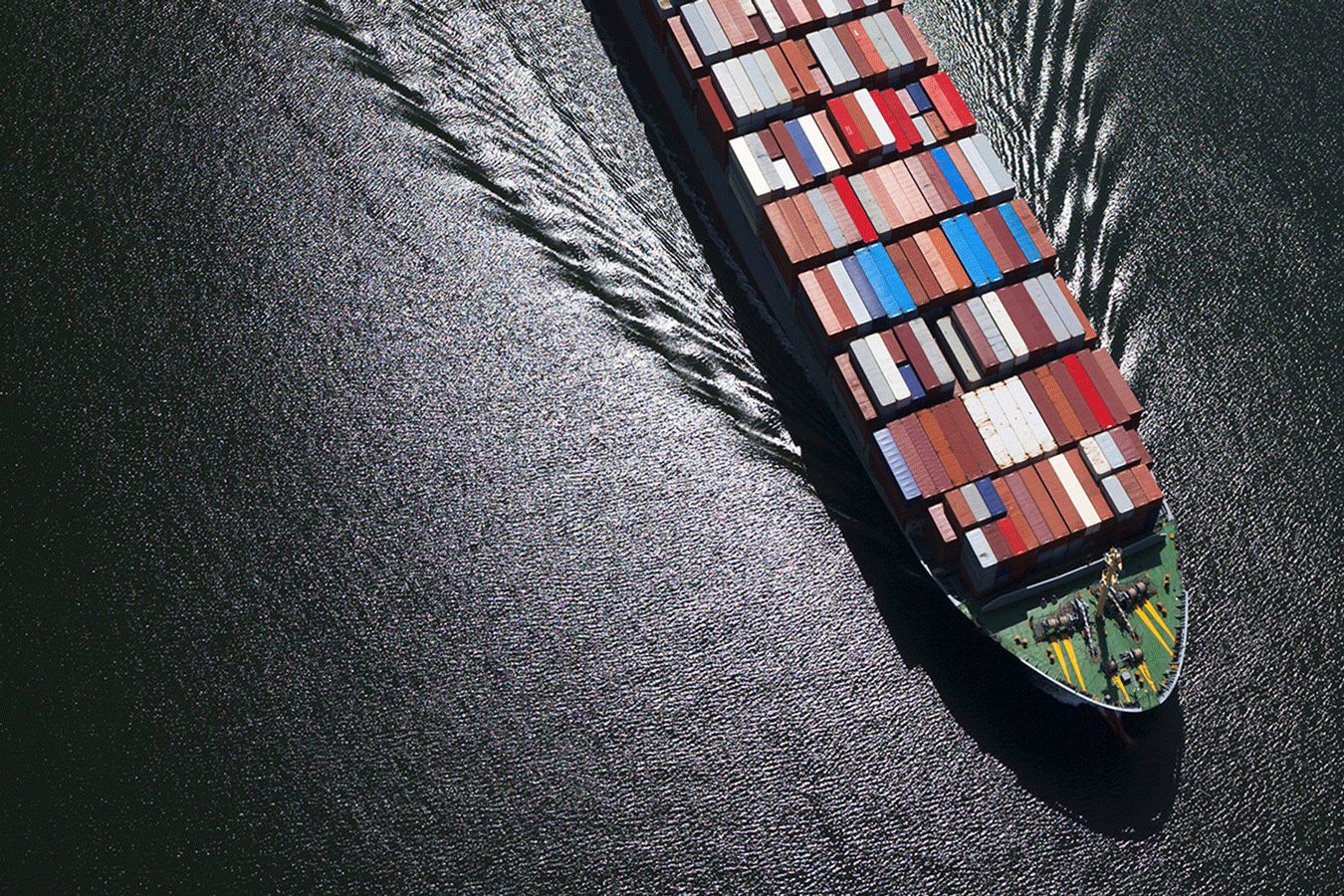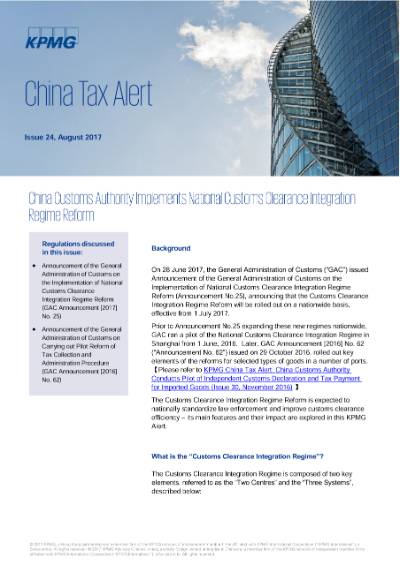- Home ›
- China Customs Authority Implements National Customs...
China Customs Authority Implements National Customs Clearance Integration Regime Reform
China Customs Authority Implements National Customs...
China Tax Alert - Issue 24, August 2017

Background
On 28 June 2017, the General Administration of Customs (“GAC”) issued Announcement of the General Administration of Customs on the Implementation of National Customs Clearance Integration Regime Reform (Announcement No.25), announcing that the Customs Clearance Integration Regime Reform will be rolled out on a nationwide basis, effective from 1 July 2017.
Prior to Announcement No.25 expanding these new regimes nationwide, GAC ran a pilot of the National Customs Clearance Integration Regime in Shanghai from 1 June, 2016. Later, GAC Announcement [2016] No. 62 (“Announcement No. 62”) issued on 29 October 2016, rolled out key elements of the reforms for selected types of goods in a number of ports. 【Please refer to KPMG China Tax Alert: China Customs Authority Conducts Pilot of Independent Customs Declaration and Tax Payment for Imported Goods (Issue 30, November 2016) 】
The Customs Clearance Integration Regime Reform is expected to nationally standardize law enforcement and improve customs clearance efficiency – its main features and their impact are explored in this KPMG Alert.
What is the “Customs Clearance Integration Regime”?
The Customs Clearance Integration Regime is composed of two key elements, referred to as the “Two Centres” and the “Three Systems”, described below:
1. Two Centres
- Three National Customs Risk Prevention and Control Centres (“RPCCs”) are to be established in Shanghai, Huangpu and Qingdao. RPCCs shall provide high-level oversight and management for customs risk prevention and control activities, which are carried out at customs clearance points across China. These look to ensure safe entry of goods imported by air, land and sea (except for small craft commuting between Hong Kong and Macau).
Furthermore, RPCCs are responsible for setting safe entry parameters for paperless clearance for: import and export licenses, certificates of origin, CCC certifications, CIQ certificates, as well as setting tax collection and administration standards. - Three Tax Collection and Administration Centres (“TCAC”s) are to be established in Beijing/Tianjin, Shanghai and Guangzhou. These will verify the accuracy of tax filings for goods imported through all Chinese ports. They will examine in particular use of appropriate HS code classifications, valuations, country of origin declarations, with specialization as follows:
| TCAC | Responsible categories of imported goods | Responsible HS codes |
|---|---|---|
| Beijing, Tianjin | Agricultural and forestry products, prepared foodstuffs, pharmaceutical products, light industry products, miscellaneous manufactured articles, textile articles, aircrafts, etc. | 58 chapters (Chapter 1 to 24, Chapter 30, Chapter 41-67, Chapter 88, Chapter 93-97), 3461 tariff codes in total |
| Shanghai | Machinery and electrical equipment (electromechanical instruments and meters, transportation vehicles, etc.) | 8 Chapters (Chapter 84 to 87, Chapter 89 to 92), 2286 tariff codes in total |
| Guangzhou | Chemical products (chemical raw materials, high-polymer products, energy products, mineral products and metal products) | 30 Chapters (Chapter 25 to 29, Chapter 31-40, Chapter 68-83), 2800 tariff codes in total |
2. Three systems
The three customs clearance regime systems rolled out by Announcement No.25 include “One Declaration with Review in Stages”, “Reform of Tax Collection and Administration Procedures”, and “Cooperative Supervision”:
- “One declaration with review in stages” will separate the safe entry supervision and tax collection supervision process steps. At Step 1, RPCCs will analyze and verify the safe entry parameters of imported commodities, such as the product name of the commodity, quantity, weight, and whether the goods belong to restricted/prohibited goods types. Once the entry risk review is cleared, the goods are released upon the payment of import taxes or the corresponding deposit. At Step 2, TCACs will analyze and verify tax relevant matters such as tariff classification, valuation, country of origin of the commodities.
- “Reform of Tax Collection and Administration Procedures” will strengthen enterprise responsibilities to make truthful declarations and proper payment of import taxes. The review of tax-relevant matters will no longer just take place at the customs clearance stage but will be conducted as part of a comprehensive review throughout the whole import supervision process. The verification of customs declarations will no longer be conducted on each shipment at the time of customs clearance, but on selected shipments chosen by random check.
- “Cooperative supervision” will institute a clearer ‘division of labour’ between the various entities within the Chinese customs administration. Port customs will mainly supervise transportation, importation of goods and personal articles, as well as customs special supervision areas. In-charge customs (i.e. the customs authority with which an importer/exporter registers) will mainly manage the customs audit, customs enterprise credit management and other post-importation supervision and compliance management. At the same time, the customs audit team, the anti-smuggling team and the customs clearance supervision team (i.e. RPCCs and TCACs) will each play specialized roles, in coordination with the port customs and in-charge customs authorities.
With the three Systems, administration of import/export declarations will follow three steps:
Step 1 Inspection before release of goods
RPCCs shall analyze whether the imported goods have safe entry risks such as being restricted/forbidden imports, giving rise to patent and trademark infringement, or involving untruthful declarations of commodity name or description, specification and quantity. Instructions will be given by RPCCs to on-site customs personnel to inspect specific batches of imported goods. TCACs shall conduct risk analysis of tax-related matters before release of goods, and instruct on-site customs personnel to carry out on-site goods verification and examination in case of significant tax collection risk.
Step 2 Risk screening after release of goods
TCACs will conduct post-importation batch review on tax-related matters in customs declaration forms, screen and select high-risk importations, carry out verification work. TCACs will reach out to the companies or instruct in-charge customs authorities to conduct audits, after the release of goods.
Step 3 Regular or special audit performed by in-charge customs
The in-charge customs will be mainly responsible for performing post-import supervision through regular or special audits.
KPMG observations
After the implementation of National Customs Clearance Integration Regime on a nationwide basis, the majority of imported goods will be released after the importer declaration passes the automated system review (i.e. after the computer system checks that all the relevant information has been included on the electronically filed customs declaration form). Manual review of customs declaration documents is estimated to reduce to less than 10% of imports following the rollout of the new system. TCACs will perform batch review on the tax-related matters in approximately 20% of the importer self-declarations after the release of goods. A comparison between the old and new regimes is set out below:
| Old regime | New regime | |
|---|---|---|
| Declaration process | Most importations are to be reviewed before release of goods for inspection on consistency with declaration documents | Most of the customs clearance will be completed through independent customs declaration while high risk imports will be filtered out for further review before release of goods |
| Tax collection and administration | Valuation and HS code classification of imported goods will be reviewed before release of goods and post-importation audit will be performed by customs audit and other function sectors | Customs enhances comprehensive customs inspection and audit after release of goods |
Enterprises are likely to benefit from the implementation of National Customs Clearance Integration Regime as follows:
Declaration at location different from importation port
Enterprises are entitled to choose a suitable port and clearance mode for customs declaration. For example, an enterprise could import goods at Port A while it declares with local Customs located in Port B. Before the reform, imports and customs declarations needed to be conducted at the same port of entry, or at the in-charge Customs upon approval from the port of entry.
Consistent law enforcement by Customs
Different regional customs authorities used to have different interpretations of customs policies and regulations. This resulted in the same imported goods being subject to different taxation treatment at different ports.
Under the new regime, the three TCACs are expected to conduct uniform high-level inspection and risk review of importations nationwide, to minimize the inconsistency of regulation enforcement by local Customs. Enterprises can establish unified operating process standards, and centralize customs clearance procedures to reduce expenditure of time and operating costs. They can consequently shift more focus to customs risk control and internal process improvement.
Improvement of customs clearance efficiency
According to the statistics from Customs, average customs clearance time has been reduced by one third since 1 July 2017. It is expected that the clearance time will continue to reduce. It can be foreseen that after the implementation of the National Customs Clearance Integration system, Customs will devote greater resources to post-import supervision. Enterprises are consequently expected to encounter more custom inspection and audit and are recommended to optimize internal processes, and utilize periodic self-inspections and voluntary disclosure mechanisms.
KPMG assistance
In responding to the changing environment of Customs supervision, KPMG can help companies with the following:
- Assistance in conducting customs compliance self-inspection through analyzing enterprise historical import data. By discovering mistakes on a timely basis, KPMG can help enterprises to prepare self-inspection reports and perform voluntary disclosure with China Customs. KPMG can also provide procedure improvement recommendations to mitigate future compliance risks;
- Assistance in strengthening customs compliance management. This includes enhancing management of import/export duty filing and settlement (i.e. customs valuation and tariff classification, etc.), management of bonded operations, management of duty-exempted/reduced equipment, and other internal controls;
- Assistance in rolling out system solutions to incorporate customs declarations/post-clearance review into automated processes, and reduce errors from manual handling of customs declarations.
© 2025 KPMG Huazhen LLP, a People's Republic of China partnership, KPMG Advisory (China) Limited, a limited liability company in Chinese Mainland, KPMG, a Macau SAR partnership, and KPMG, a Hong Kong SAR partnership, are member firms of the KPMG global organisation of independent member firms affiliated with KPMG International Limited, a private English company limited by guarantee. All rights reserved.
The KPMG name and logo are trademarks used under license by the
independent member firms of the KPMG global organisation.
For more detail about the structure of the KPMG global organisation please visit https://kpmg.com/governance.
Connect with us
- Find office locations kpmg.findOfficeLocations
- kpmg.emailUs
- Social media @ KPMG kpmg.socialMedia
Stay up to date with what matters to you
Gain access to personalized content based on your interests by signing up today

